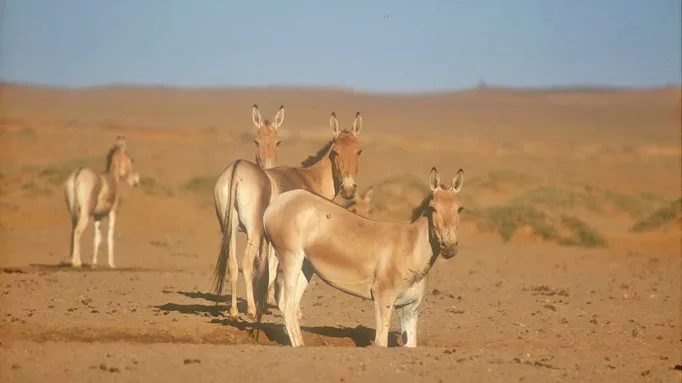What Animals Live In The Gobi Desert
Rare animals in the Gobi Desert
The Gobi'southward fauna is diverse and owned, with various large mammals that are adapted particularly well to the farthermost natural weather condition. Ibexes, wild sheep, marmots, and birds of casualty such as gold eagles and bearded vultures reside in the mountains, whereas its steppes are home to white gazelles, black-tailed antelopes, and corsac foxes. In that location are also extremely rare wildlife such equally Wild Bactrian camel, Mongolian wild donkey, snowfall leopard and the Gobi bear.

Wild Bactrian camel
The Wild Bactrian camel or Camelus ferus, separated from any other form of camel over 700,000 years agone, is the simply truthful wild camel species in the world, recognized past the International Union for the Conservation of Nature (IUCN), which controls the Red Volume of Endangered Species. Out of 900–1,000 individuals left in the wild, approximately 600 live in the Mongolian Gobi and the IUCN lists it as critically endangered. Its humps are smaller, lower, and more than conical in shape than those of the domestic Bactrian camel. Unlike its domestic counterpart, its wool is shorter and always sandy colored. They can survive on water saltier than seawater, an power that no other mammal in the world, including the domestic Bactrian camel, possess.

Mongolian wild ass
The Mongolian wild donkey is believed to be a subspecies of the onager, that can but be seen in the Gobi Desert. It was previously institute in eastern Kazakhstan and southern Siberia earlier being extinct there through hunting. The fauna is an herbivore that can live on the thin grasses, shrubs, and trees found in the barren environment of the Gobi. The herds movement in a nomadic pattern, pursuing unpredictable resources in their desert environment. They tin can travel thousands of kilometers in just a few weeks in search of nutrient and water, and their annual range can cover up to 70,000 square km. The Mongolian wild ass is known to dig holes at dry riverbeds and water sources to access to subsurface h2o during hot summers in the Gobi Desert. Watering holes dug by them are also used by other species also as by humans to access to water. They were recorded as a nearly-threatened species by the IUCN in 2015, about 23,000 mature individuals are estimated to live in the Mongolian Gobi and 5,000 individuals in Northern Cathay.

Gobi Comport
The Gobi Carry, with a population around xxx – 40 adults in the wild, is a subspecies of the chocolate-brown bear that can be found only in the Mongolian office of the Gobi Desert. Listed as critically endangered, the Gobi bears are omnivorous, eating roots, berries, plants, and rodents. There is no record of them preying on large mammals. Adult Gobi bears counterbalance around 100 to 130 kg and females weigh around fifty to 80 kg, making them considerably smaller than pandas. There are both international and local organizations working to save these animals from extinction by studying their behavior and improving the environment.

Snow leopard
The snow leopard, a big cat distinguished by its thick platinum fur marked by dark spots, is listed as vulnerable on the IUCN Ruby List, with a global population of less than 8,000 individuals. Out of 1000 snow leopards that are present in Mongolia, the half inhabit in mountains of the Gobi Desert. They are the summit predators in the region, mostly hunting ibexes. Information technology has long and powerful back legs which enable information technology to jump as far every bit 15 grand.

Since the Gobi Desert became a world awareness in the 1920s when a paleontological expedition held by the American Museum of Natural History discovered the first confirmed dinosaur eggs in the world it has been attracting scientists and travelers from all over the globe.
Gobi Desert Tours
The Gobi is one of the earth'south least densely populated regions, with nomadic families living far apart, much due to the lack of water resource and adept grazing areas. Many of these nomads has been herding Bactrian camels traditionally, and large herds can however exist seen today, gently walking along the vast plains. We welcome you to choose one of our Gobi Desert tours for in one case in a lifetime experience.
VIEW GOBI TOURS
Source: https://www.mongolian-ways.com/travel-blog/animals-gobi-desert
Posted by: stephenbuslow.blogspot.com

0 Response to "What Animals Live In The Gobi Desert"
Post a Comment